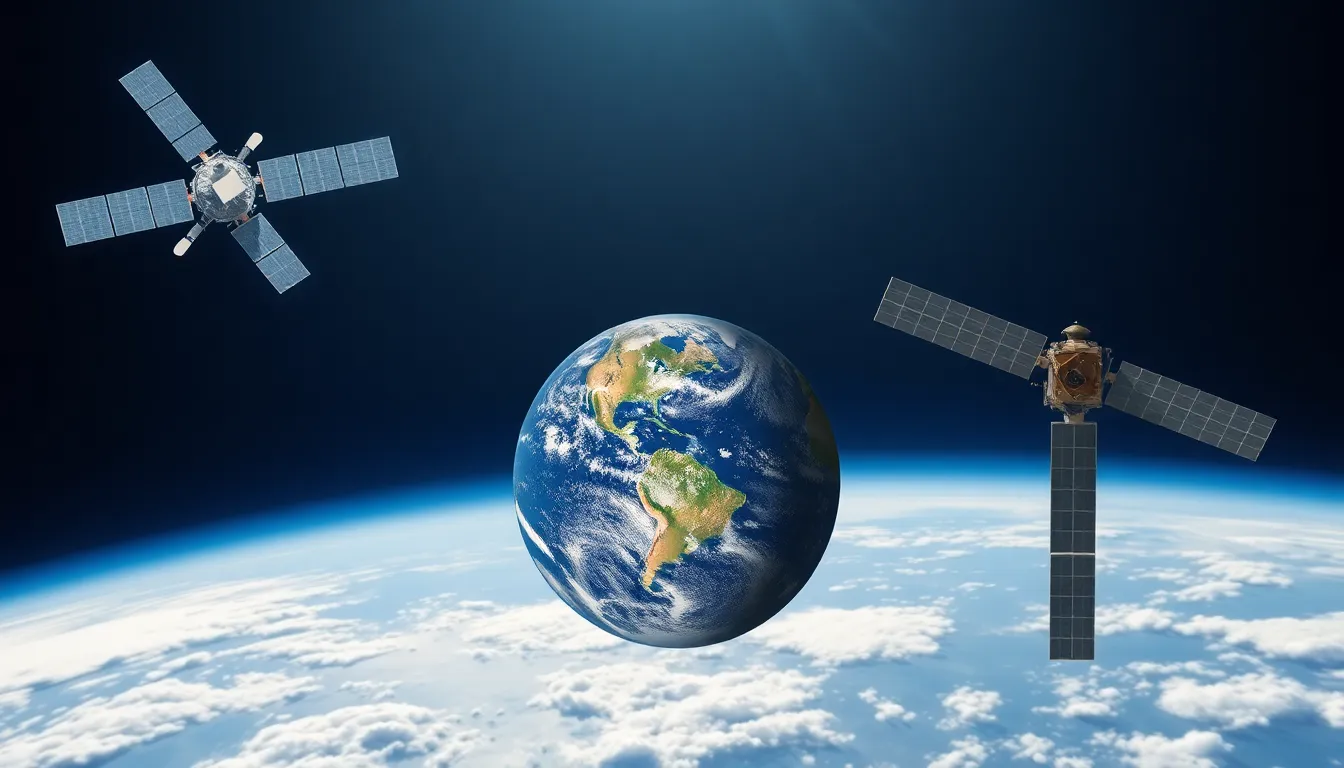In a world where GPS can find the nearest taco truck and satellite TV delivers endless binge-worthy shows, satellite technology isn’t just cool—it’s essential. These high-flying marvels orbiting our planet do more than just beam down cat videos; they play a crucial role in communication, weather forecasting, and even disaster relief.
Imagine a time when we relied on maps that folded more than a paper airplane. Thanks to satellites, we can navigate with ease, stream our favorite shows, and stay connected with loved ones across the globe. As technology evolves, the impact of satellites continues to expand, making life a little more convenient and a lot more interesting. Buckle up as we explore the fascinating world of satellite technology and its incredible influence on our daily lives.
Table of Contents
ToggleOverview of Satellite Technology
Satellite technology serves multiple vital functions across various sectors. Communication satellites enable instant connectivity, supporting phone calls, internet access, and television broadcasts. Weather satellites monitor atmospheric conditions, allowing meteorologists to provide timely forecasts and warnings for severe weather events.
Navigation satellites, such as those in the Global Positioning System (GPS), enhance travel experiences, offering precise location data for both personal and commercial use. Earth observation satellites collect data on land use changes, natural resources, and environmental monitoring. This information aids in decision-making for urban planning and resource management.
The evolution of satellite technology includes significant advancements in miniaturization and functionality. Smaller satellites, including CubeSats, offer cost-effective solutions for various applications, such as scientific research and telecom. The deployment of mega-constellations, like SpaceX’s Starlink, aims to enhance global internet coverage, particularly in rural areas.
Regulations surrounding satellite operations and space traffic management continue to evolve. Organizations like the International Telecommunication Union (ITU) implement guidelines to ensure proper frequency usage and satellite positioning. Such policies help mitigate potential collisions and congestion in Earth’s orbit.
With ongoing innovations, satellite technology enhances the quality of life. Applications range from precision agriculture to environmental monitoring, demonstrating its versatility and wide-reaching impact. Maintenance of the satellite systems ensures sustainable operation, while partnerships between private and public sectors foster continuous advancements in this field.
Types of Satellites

Various satellite types serve distinct functions, each contributing to specific advancements in technology and society.
Communication Satellites
Communication satellites facilitate global connectivity. They transmit signals for telephone calls, internet access, and television broadcasts. Geostationary satellites orbit at 22,236 miles above Earth, enabling uninterrupted communication with ground stations. Low Earth Orbit satellites, located between 100 to 1,200 miles above ground, offer improved bandwidth and reduced latency for users. Operators like SES and EchoStar deploy multiple satellites, ensuring coverage in urban and rural areas. Both types enhance the way people connect and consume information.
Earth Observation Satellites
Earth observation satellites monitor and collect data about the planet. These satellites use various sensors to track changes in land use, weather patterns, and natural disasters. Notably, Landsat satellites provide images that inform urban planning and environmental assessments. Sentinel satellites contribute valuable data for climate research and disaster management. With advancements in remote sensing technology, these satellites enhance scientific understanding and support informed decision-making in numerous fields.
Navigation Satellites
Navigation satellites primarily assist in positioning and tracking. The Global Positioning System (GPS) relies on at least 24 satellites circulating the planet to provide accurate location information to users. Ground receivers calculate their position by triangulating signals from multiple satellites. Other systems, like Galileo and GLONASS, offer similar services, promoting global navigation capabilities. These satellites benefit industries such as transportation, agriculture, and emergency response, enhancing efficiency and safety across diverse applications.
Applications of Satellite Technology
Satellite technology plays a crucial role across various sectors, enhancing capabilities and improving outcomes.
Telecommunications
Telecommunications satellites support global communication infrastructures. They enable direct phone calls and internet access for millions around the world. These satellites operate in geostationary or low Earth orbits, providing extensive coverage and minimal latency. Companies like Intelsat and SES utilize these systems to deliver television broadcasts and data communication services. Furthermore, advancements in satellite technology foster the growth of 5G networks, increasing data speeds and connectivity.
Weather Forecasting
Weather forecasting relies heavily on satellites for accurate data collection and real-time monitoring. Meteorological satellites capture detailed images of weather patterns, enabling forecasters to predict severe weather events, such as hurricanes and tornadoes. National Oceanic and Atmospheric Administration (NOAA) satellites play a pivotal role in tracking storms and issuing timely warnings. These capabilities not only save lives but also mitigate economic losses by informing communities of impending weather conditions. Enhanced satellite data leads to more effective climate models, improving long-term weather predictions.
Environmental Monitoring
Environmental monitoring depends on satellite technology to assess and manage natural resources. Earth observation satellites gather data on land use, deforestation, and climate change, aiding in responsible decision-making. Organizations like NASA and the European Space Agency utilize these satellites to monitor pollution and track wildlife habitats. This information supports efforts in conservation and sustainable development. Additionally, satellite imagery enables scientists to study natural disasters, contributing to better preparedness and response strategies.
Advancements in Satellite Technology
Recent advancements in satellite technology have transformed various sectors, driving efficiency and enhancing capabilities. These developments include miniaturization, improved launch access, and increased international collaboration.
Miniaturization of Satellites
Miniaturization has revolutionized satellite design, with smaller satellites like CubeSats becoming an affordable choice for multiple applications. Various organizations utilize these compact satellites for tasks ranging from Earth observation to scientific research. Enhanced capabilities of miniaturized satellites include advanced sensors and imaging technology, which yield high-resolution data. Smaller satellites lower costs significantly, making space accessible to startups, educational institutions, and developing countries. The trend toward smaller, more agile satellites aligns with ongoing efforts to democratize access to space-based resources.
Increased Launch Access
Increased launch access has paved the way for more frequent and cost-effective satellite deployments. Emerging launch providers offer flexible pricing structures and innovative payload capacities, drawing interest from commercial ventures and governmental agencies alike. Numerous launch facilities across the globe support a wider array of missions, accommodating various satellite sizes and types. Additionally, partnerships between nations enhance collaborative efforts in satellite launches, enabling shared technology and resources. Driving competition among launch service providers fosters further innovations, ensuring advancements in satellite technology continue at an accelerated pace.
Challenges in Satellite Technology
Challenges in satellite technology impact its effectiveness and implementation. Space debris poses a significant risk, while regulatory issues complicate satellite operations.
Space Debris
Space debris consists of defunct satellites, spent rocket stages, and fragments resulting from collisions. These objects orbit Earth at high speeds, increasing the likelihood of accidents with operational satellites. The European Space Agency estimates that over 36,000 pieces of debris larger than 10 cm exist in Earth’s orbit. Safeguarding satellites requires careful tracking and management of this debris. Innovative solutions like active debris removal and better satellite design aim to minimize risks from this growing problem.
Regulatory Issues
Regulatory issues present another challenge in satellite technology. National and international guidelines govern satellite launches, frequency allocations, and orbital positions. Regulations from the International Telecommunication Union ensure that satellites operate without causing interference with each other. Additionally, nations must work together to prevent orbital congestion and collisions. Navigating these complex regulations proves crucial for satellite operators. Emerging technologies demand updated policies, requiring ongoing dialogues among governments and organizations.
Satellite technology is a cornerstone of modern society that impacts daily life in countless ways. As innovations continue to emerge the potential for enhanced connectivity and improved services will only expand. The ongoing development of smaller and more efficient satellites promises to democratize access to space while addressing challenges like space debris and regulatory complexities.
The future of satellite technology looks promising with collaborative efforts paving the way for groundbreaking advancements. As industries evolve and adapt to these technologies the benefits will resonate across sectors, enhancing everything from communication to environmental monitoring. Embracing these changes will be crucial for harnessing the full potential of satellite technology in the years to come.




